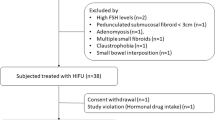Abstract
Background
High intensity focused ultrasound (HIFU) is a novel method which offers the non-invasive ablation of tissues without harming overlying organs or skin. It has been introduced successfully in urology for the ablation of prostatic hyperplasia and seems to be promising in the treatment of uterine fibroids. In this study we aimed to examine the feasibility and possible side effects of HIFU treatment of uterine tissues using an experimental mobile HIFU unit with ultrasound guidance.
Methods
For these experiments, a 1.07 MHz ultrasound source was used which allows treatment depths between 0 and 10 cm. In 12 patients scheduled to have abdominal hysterectomy, 5–60 impulses of HIFU were applied through the intact skin upon uterine tissues directly prior to the surgical procedure. Tissue intensities lay between 3,200 and 6,300 W/cm² and a fixed pulse length of 4 s was used.
Results
No side effects were encountered other than one first-degree skin burn and the treatment was well tolerated. Histology showed clearly demarcated coagulative necrosis in the targeted tissues. Treatment was concluded in less than 45 min for each patient.
Conclusion
Focused ultrasound is an effective method to selectively destroy tissue within the uterus and the transabdominal access route is very feasible. This study shows that a mobile ultrasound source can be used safely and effectively to destroy uterine tissues, such as fibroids, without major side effects.










Similar content being viewed by others
References
Sawin SW, Pilevsky ND, Berlin JA, Barnhart KT (2000) Comparability of perioperative morbidity between abdominal myomectomy and hysterectomy for women with uterine leiomyomas. Am J Obstet Gynecol 183(6):1448–1455
Pelage JP, Le Dref O, Soyer P, Kardache M, Dahan H, Abitbol M, et al (2000) Fibroid-related menorrhagia: treatment with superselective embolization of the uterine arteries and midterm follow-up. Radiology 215(2):428–431
Stewart EA (2001) Uterine fibroids. Lancet 357:293–298
ter Haar G (1995) Ultrasound focal beam surgery. Ultrasound Med Biol 21:1089–1100
Fry WJ, Mosberg WH Jr, Barnard JW, Fry FJ (1954) Production of focal destructive lesions in the central nervous system with ultrasound. J Neurosurg 11(5):471–478
Gelet A, Chapelon JY, Bouvier R, Rouviere O, Lasne Y, Lyonnet D, et al (2000) Transrectal high-intensity focused ultrasound: minimally invasive therapy of localized prostate cancer. J Endourol 14:519–528
Randal J (2002) High-intensity focused ultrasound makes its debut. J Natl Cancer Inst 94:962–964
Wang X, Sun J (2002) High-intensity focused ultrasound in patients with late-stage pancreatic carcinoma. Chin Med J (Engl) 115:1332–1335
Wu F, Wang ZB, Cao YD, Chen WZ, Bai J, Zou JZ, et al (2003) A randomised clinical trial of high-intensity focused ultrasound ablation for the treatment of patients with localised breast cancer. Br J Cancer 89(12):2227–2233
Vaezy S, Fujimoto VY, Walker C, Martin RW, Chi EY, Crum LA (2000) Treatment of uterine fibroid tumors in a nude mouse model using high-intensity focused ultrasound. Am J Obstet Gynecol 183:6–11
Keshavarzi A, Vaezy S, Noble ML, Paun MK, Fujimoto VY (2003) Treatment of uterine fibroid tumors in an in situ rat model using high-intensity focused ultrasound. Fertil Steril 80(Suppl 2):761–767
Tempany CM, Stewart EA, McDannold N, Quade BJ, Jolesz FA, Hynynen K (2003) MR imaging-guided focused ultrasound surgery of uterine leiomyomas: a feasibility study. Radiology 226:897–905
Stewart EA, Gedroyc WM, Tempany CM, Quade BJ, Inbar Y, Ehrenstein T, et al (2003) Focused ultrasound treatment of uterine fibroid tumors: safety and feasibility of a noninvasive thermoablative technique. Am J Obstet Gynecol 189:48–54
Köhrmann KU, Michel MS, Steidler A, Marlinghaus E, Kraut O, Alken P (2002) Technical characterization of an ultrasound source for noninvasive thermoablation by high intensity focused ultrasound. BJU Int 90:248–252
Hill CR, Rivens MG, Vaughan MG, ter Haar GR (1994) Lesion development in focused ultrasound surgery: a general model. Ultrasound Med Biol 20:259–269
Nizard J, Pessel M, De Keersmaecker B, Barbet JP, Ville Y (2004) High-intensity focused ultrasound in the treatment of postpartum hemorrhage: an animal model. Ultrasound Obstet Gynecol 23:262–266
Vaezy S, Martin R, Keilman G, Kaczkowski P, Chi E, Yazaji E, et al (1999) Control of splenic bleeding by using high intensity ultrasound. J Trauma 47:521–525
Vaezy S, Noble ML, Keshavarzi A, Paun M, Prokop AF, Cornejo C, et al (2004) Liver hemostasis with high-intensity ultrasound: repair and healing. J Ultrasound Med 23:217–225
Cornejo CJ, Vaezy S, Jurkovich GJ, Paun M, Sharar SR, Martin RW (2004) High-intensity ultrasound treatment of blunt abdominal solid organ injury: an animal model. J Trauma 57:152–156
Poliachik SL, Chandler WL, Ollos RJ, Bailey MR, Crum LA (2004) The relation between cavitation and platelet aggregation during exposure to high-intensity focused ultrasound. Ultrasound Med Biol 30:261–269
Chen L, Rivens I, Ter Haar G, Riddler S, Hill CR, Bensted JPM (1993) Histological changes in rat liver tumours treated with high-intensity focused ultrasound. Ultrasound Med Biol 19:67–74
Susani M, Madersbacher S, Kratzik C, Vingers L, Marberger M (1993) Morphology of tissue destruction induced by focused ultrasound. Eur Urol 23(suppl. 1):34–38
Author information
Authors and Affiliations
Corresponding author
Rights and permissions
About this article
Cite this article
Fruehauf, J.H., Back, W., Eiermann, A. et al. High-intensity focused ultrasound for the targeted destruction of uterine tissues: experiences from a pilot study using a mobile HIFU unit. Arch Gynecol Obstet 277, 143–150 (2008). https://doi.org/10.1007/s00404-007-0435-0
Received:
Accepted:
Published:
Issue Date:
DOI: https://doi.org/10.1007/s00404-007-0435-0




